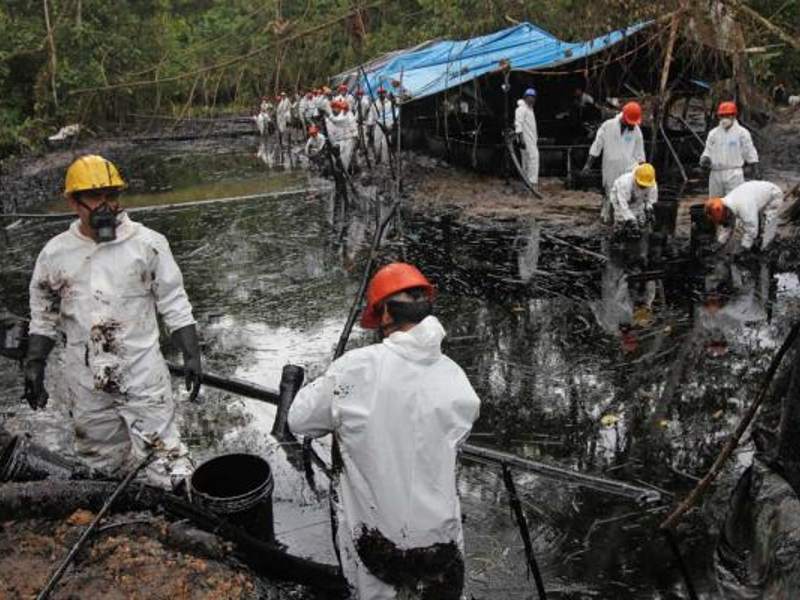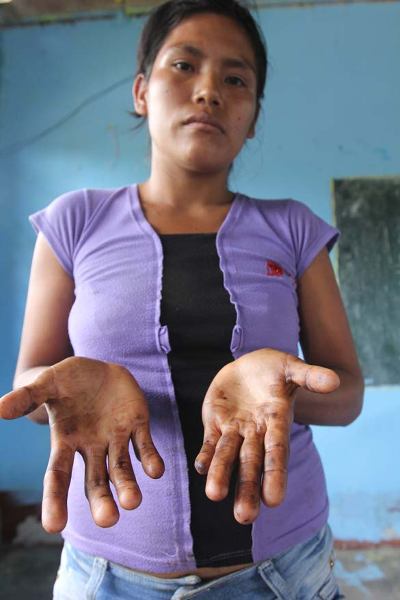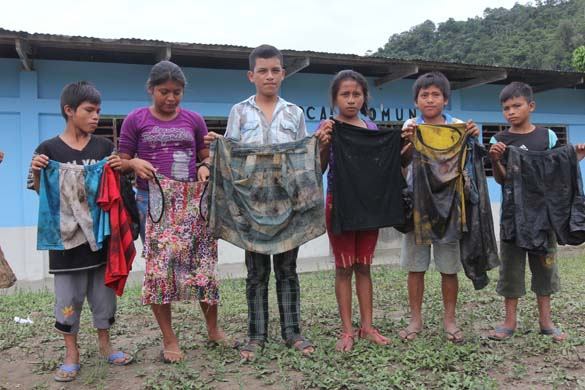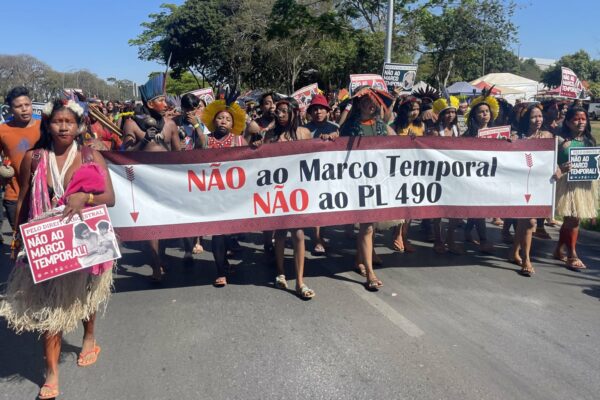
After a heavy rain washed a huge oil slick down the Chiriaco River in northern Peru, 12-year-old Elías Taijín Rivera recalls, a man in a pickup truck offered to pay villagers in the Awajún village of Nazareth for any oil they collected along the riverbank.
“We went out in a canoe and scooped oil into buckets,” said the boy, who spent most of the day on February 10 filling containers with oil, along with other children, some as young as 7 or 8.
Children and adults, including some nursing women, immersed themselves in oily water with no protective gear. Before long, many were complaining of headaches, dizziness, blurred vision or nausea. Some still have skin lesions.
And although they’d hoped to earn money for school supplies, as classes are due to start in early March, many say they received only the equivalent of a dollar or two for the oil they collected.
 Village leaders in the district of Imaza, in the northern Amazonas region, where an oil pipeline operated by the state-run company Petroperú ruptured on January 25, are worried about possible long-term health problems for people who breathed the fumes and whose bare skin was caked with crude.
Village leaders in the district of Imaza, in the northern Amazonas region, where an oil pipeline operated by the state-run company Petroperú ruptured on January 25, are worried about possible long-term health problems for people who breathed the fumes and whose bare skin was caked with crude.
They also worry about the oil spill’s impact on the river, the fish and the sandy beaches where they plant seasonal crops.
It took workers three days to stop the leak, which company officials say occurred when saturated earth shifted, causing the pipeline to buckle, spilling between 2,000 and 3,000 barrels of heavy crude.
The oil was initially confined to a stream, which overflowed with heavy rains on February 9.
For most of the next day, villagers say, a huge slick flowed down the Chiriaco River and into the Marañón River, one of the major tributaries of the Amazon. When the water level fell again, it left a meter-high oily stain on plants and soil along the riverbanks.
It also left greasy puddles in low-lying fields of cassava and banana plants in Nazareth, where residents wonder if the oil has poisoned their plants. They also worry about the fish, which traditionally provide both protein and income for families along the river.
Another pipeline break was reported February 5 near the Wampis village of Muyuriaga on the Morona River, a tributary of the Marañón in Peru’s northeastern Loreto region.
Counting those two cases, there have been 20 oil spills from the pipeline since 2011, according to Peru’s environmental oversight agency (Organismo de Evaluación y Fiscalización Ambiental, OEFA).
OEFA blamed the spills on corrosion and ordered Petroperú to immediately replace badly deteriorated sections of pipe and repair parts that showed lighter damage.
Meanwhile, the government regulatory agency that oversees energy and mining companies fined Petroperu $3.6 million for failure to upgrade the pipeline and ensure safety.
The government declared a health emergency on February 17, a measure meant to ensure medical attention and a supply of safe drinking water, but assistance was slow to arrive.
Health officials from the Amazonas region and a representative of Petroperú finally met with leaders and residents of affected communities on February 20 in Nazareth. Some participants expressed frustration that the meeting did not provide a comprehensive response to the problem.
 Oil spills from the pipeline can have lingering effects. The Kukama community of Cuninico, in the lower part of the Marañón watershed, still has not recovered from a spill in June 2014, when nearly 2,000 barrels leaked from the pipeline, according to Galo Vásquez, the community’s apu or president.
Oil spills from the pipeline can have lingering effects. The Kukama community of Cuninico, in the lower part of the Marañón watershed, still has not recovered from a spill in June 2014, when nearly 2,000 barrels leaked from the pipeline, according to Galo Vásquez, the community’s apu or president.
Despite eight months of cleanup, traces of oil continue to float down the Cuninico River and people are afraid to eat fish from lakes that were once the area’s richest fishing spots. Buyers also shun fish from Cuninico, drying up a key source of income for families, Vásquez said.
The spill in Cuninico has dropped out of the public eye. Reaching the village requires travel by air, road and river, while Nazareth and the other communities affected by the January 25 spill are accessible by road.
TV magazine programs on the night of February 21 included an interview with a 12-year-old boy in Nazareth who still had a rash from collecting crude from the river.
Two days later, Petroperú announced that it would cover the boy’s medical care. But regional health officials have a list of 204 people, including 82 children and adolescents under age 19, who were also exposed to the oil when they scooped it out of the river. And that list is probably incomplete.
Although the company has promised to leave the land and waterways as clean as they were before the spill, even children are worried about the future.
As rains swell the rivers and flood the fields, and no one knows whether the fish are contaminated, Elías Taijín says, “How are we going to eat?”














